|
Connection to the Earth Science Curriculum
Essential
Lessons:
1. Sandstone is classified as which basic type
of rock? Igneous, sedimentary or metamorphic?
Explain your answer.
2. What is the name of the rock type
that copper is found in? Explain how it formed.
3. What does a fined grained igneous
rock tells us about how it formed?
Earth Science Literacy
Principles-
Big Idea 2: Earth is 4.6 billion years
old.
2.1 Earth’s rock and other materials
provide a record of its history.
2.4 Earth’s crust has two distinct types, continental and
oceanic.
2.7 Over Earth’s vast history, both gradual and catastrophic
processes have produced enormous changes.
Big Idea 7: Humans depend on Earth for
resources
7.3 Natural resources are limited
7.6 Soil, rocks and minerals provide essential metals and other
materials for agriculture, manufacturing and building.
Common misconceptions
All rocks and planets were formed at the some time.
Rocks have very little practical use.
All rocks are more or less the same (a rock is a rock!)
Michigan State Science Content Expectations
Addressed:
High School »ES4.A Explain the relationship between the rock cycle
and plate tectonics and describe the processes that change one kind
of rock into another.
Vocabulary
Igneous- Rocks that form from the
cooling and hardening of lava or magma.
Sedimentary- Rocks that form from
preexisting rocks that have been broken down into sediments.
Metamorphic- Rocks that form from
existing rocks that have undergone heat and pressure.
Rift- An area in the Earth’s
crust that is spreading apart. Magma or lava erupts from the
opening.
Vesicles- Small rounded holes in
volcanic rocks caused by bubbles trapped as lava cools.
Weathering-The disintegration and
breaking down of rock at or near Earth’s surface.
Erosion- The transportation of
Earth’s materials by water, wind or ice.
Shale-A fine grained sedimentary rock
of clay or mud sized particles compressed together.
Faulting-A fracture or break in a rock
due to movement.
Amygdaloids- A gas bubble in volcanic
rock that has been filled in with minerals.
Limestone-A fine grained chemical
sedimentary rock formed from sediment made of shells and organisms
that settle to the bottom of the ocean floor.
Erratic-A rock that has been
transported from its place of origin and is different than the
surrounding bedrock.
Access Information:
Dr. William Rose
Michigan Tech University
1400 Townsend Dr.
Houghton, MI 49931
Date Visited:
Friday, July 15th, 2011
|
The Keweenaw Boulder
Garden
EarthCache
When you visit the Keweenaw Boulder Garden,
you get the opportunity to go back in time and experience the
geological history of Michigan. The inspiration of the garden came
from Dr. William Rose, Volcanologist, Professor of Geological
Engineering and Sciences at Michigan Tech University. He set
up the garden for both educational and aesthetic purposes. He
created this garden so that it could be used to tell the geological
story of these native Michigan rocks. He also hopes that
everyone walking by will enjoy and appreciate their beauty. The
three basic rock groups are represented here, igneous,
sedimentary and metamorphic. The rocks found here are
approximately one billion years old! Every rock has its story to
tell and the rocks in this garden are waiting for you to come and
learn their story
Dr. Rose explains that the rocks found here
were broken apart by the glaciers and then deposited out of glacial
rivers when the ice melted. The Michigan Tech campus is a
flat terrace formed from outwash that had boulders on top of it
before the university was built. During the construction of
the University, many of the boulders were moved out of the way. So
now, the boulders have been put back where they belong, creating a
glacial terrace with a variety of boulders for you to explore and
study.
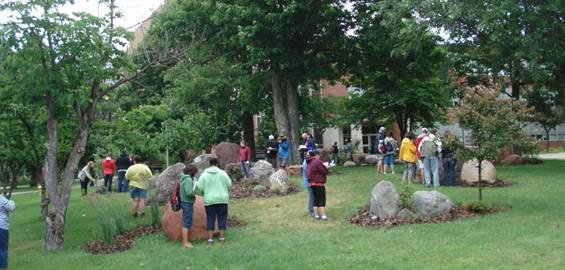
Figure 1.
Keweenaw Boulder Garden. MiTEP students identifying
boulders.
Coordinates:
47°07.110’N 88°32.725’W
Location
Michigan Tech University
1400 Townsend Dr.
Houghton, MI 49931
Figure 2.
Campus Map. Michigan Tech University.
A brief
history lesson of Keweenaw rocks
About one billion years ago there was a giant
rift which caused major volcanic eruptions in this
area. The lava cooled into basalt. Gases bubbled up to
the top layers of the basalts forming vesicles.
There were alternating periods of rift
eruptions which formed the basalts. These were accompanied and
followed by periods of weathering and erosion of the
rift walls and the formation of conglomerates.
The weight of these alternating layers caused
the whole area to sink in the center forming a large
“U-shaped” depression.
When the eruptions stopped, erosion continued
and conglomerates, sandstones and shale’s were
deposited.
Next, these basalts and conglomerates went
through a period of movement. The rock formations underwent
faulting, fracturing and tilting. Heat caused the hot
water within the rock to rise up through these fractures carrying
minerals including copper. Theses minerals accumulated in vesicles
forming amygdaloids. This is how the Upper Peninsula of
Michigan developed its great copper deposits. Much of the copper
was found in the amygdaloidal basalts.
Next there was a period where the entire area was covered by a sea
for several hundred million years. During this time, marine
sediments of limestone were put down. After the sea retreated,
weathering took place and eroded some of these deposits away.
More recently (geologically speaking) there
was a gradual climate change and ice started to cover this
area. The massive weight of the ice as it gradually flowed
toward the south eroded most of the limestone away exposing
the underlying basalts and layers rich in copper.
Today much of the landscape and deposits we
see on the surface of Michigan is the result of the strong
erosional force of glaciers that have since left over 10, 000 years
ago. It was this force that broke apart, and transported this large
variety of boulders to the Mohawk Sand and Gravel quarry where Dr.
Bill Rose got the idea to create a Boulder Garden in the middle of
Michigan Techs campus. Landscape architect Lynn Watson along with
Ashok Agarwal designed the layout and placement of these
magnificent boulders. You can learn more about them by
clicking on the Michigan Tech Boulder Garden link.http://www.geo.mtu.edu/~raman/SilverI/Boulder_Garden/Welcome.html
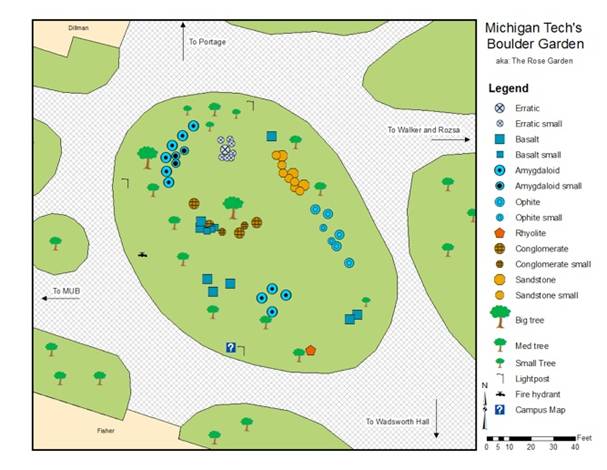
Figure 3. Diagram
of Boulder Garden.
Some of the
boulders found in the garden:
Basalt-A dark colored fine grained
igneous rock. Erupted at Earth’s surface and cooled
quickly.
Vesicular basalt-Basalt that is full of little holes that is
evidence of gas bubbles when it was lava.
Amygdaloid basalt- Vesicular basalt, but the holes are
filled with minerals.
Ophitic basalt- Basalt that contains light colored crystals
of feldspar (looks like a snow flake)
Rhyolite-Fine grained volcanic rock, cooled quickly,
usually reddish or pinkish in color, high silica content.
Conglomerate- A sedimentary rock consisting of rounded
gravel sized or larger pebbles cemented together by finer
particles.
Sandstone- A sedimentary rock of sand sized particles of
quartz cemented together.
Gneiss-A metamorphic rock that has undergone heat and
pressure causing its minerals to realign and form banding (stripe)
of the different minerals.
Granite- Coarse grained igneous rock, cooled slowly
underground, can see individual crystals of quartz feldspar and
mica, speckled pink, white, grey and black
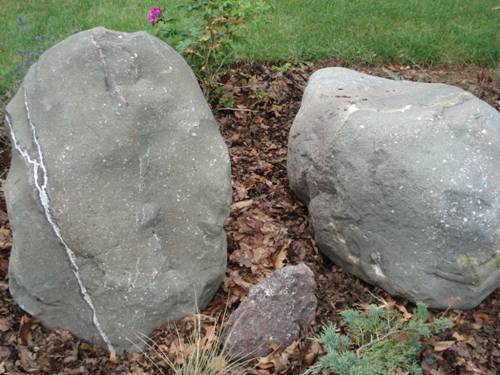
Figure 4. Basalt containing vesicles
and veins.
Notice the shape and size
of the sediment that makes this rock.
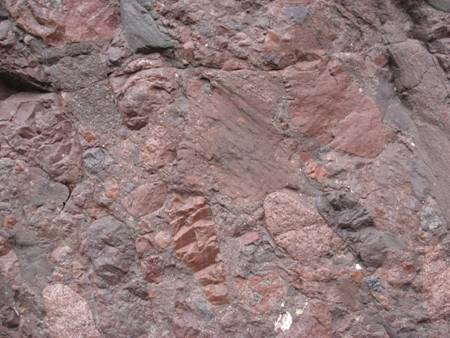
Figure 5. Close-up of
conglomerate.
Notice the grain size of this
rock as compared to a conglomerate.
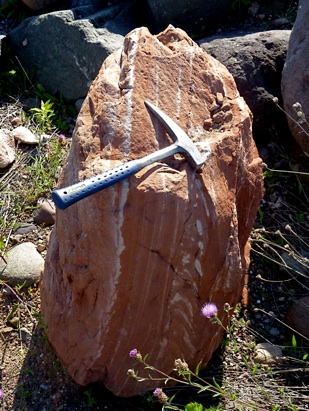
Figure 6.
Sandstone.
How did this rock get its stripes (banding)?
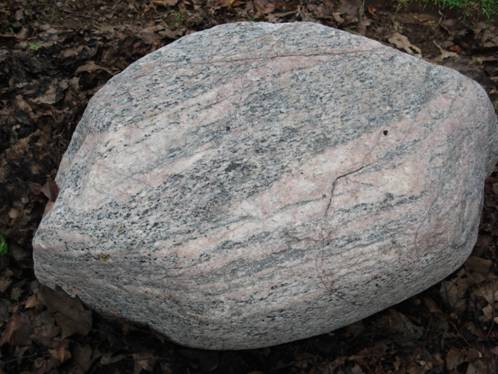
Figure 7. Gneiss.
Logging Question 1
Find the rhyolite. Rhyolite is an igneous rock. Igneous rocks are
classified by their composition and texture. Observe the rock and
answer the following questions:
Composition
Composition is defined as the minerals that make up the igneous
rock
a. Is the rhyolite light or dark in color?
If it is light, it is Felsic: made of feldspar and
quartz.
If it is dark, it is Mafic: made of
magnesium and iron.
b. What is the composition of rhyolite?
Texture
Texture of an igneous rock is determined by the size of its
individual crystals.
Small- individual crystals are hard to see with the unaided
eye.
Large- individual crystals can be seen easily.
c. What is the crystal size of the rhyolite? small or large
If the crystal size is small, it cooled quickly from lava and the
texture is fine-grained.
If the crystal size is large, it cooled slowly from magma and the
texture is coarse-grained.
d. What is the texture of the rhyolite?
e. Did the rhyolite from lava or magma?
f. Did the rhyolite cool quickly or slowly?
For more information:
To learn much more about the Boulder Garden
visit the Michigan Tech University link below:
http://www.geo.mtu.edu/~raman/SilverI/Boulder_Garden/Welcome.html
You Tube Video of Earth Day celebration in the Boulder Garden
http://www.youtube.com/watch?v=nN-dLbt1_V8
References:
Guth, Alex.
Diagram of Boulder Garden, figure 3. Retrieved July
25th, 2011 from URL:
http://www.geo.mtu.edu/~raman/SilverI/Boulder_Garden/Welcome.htm
Map of Michigan
Tech Campus, figure 2. Retrieved July 25th, 2011 from
URL: http://www.geo.mtu.edu/~raman/SilverI/Boulder_Garden/Welcome.html
originally from Google Earth.
Robinson, S.
(2001). Is this an Agate? An illustrated Guide to Lake
Superiors Beach Stones Michigan, Hancock, Michigan: Book Concern
Printers.
Rose, W. (2010,
November 15). Michigan Tech Boulder Garden. Retrieved July
25th, 2011 from URL:
http://www.geo.mtu.edu/~raman/SilverI/Boulder_Garden/Welcome.html
Rose, W.
Photograph of Sandstone, figure 6. Retrieved August
23rd, 2011.
Tarbuck and
Lutgens. (2006) Earth Science, Prentice Hall, Pearson
Education Inc.
Young,
Julie. Photographs of various boulders, figure 1, 4, 5, 7.
Taken July, 2011.
|